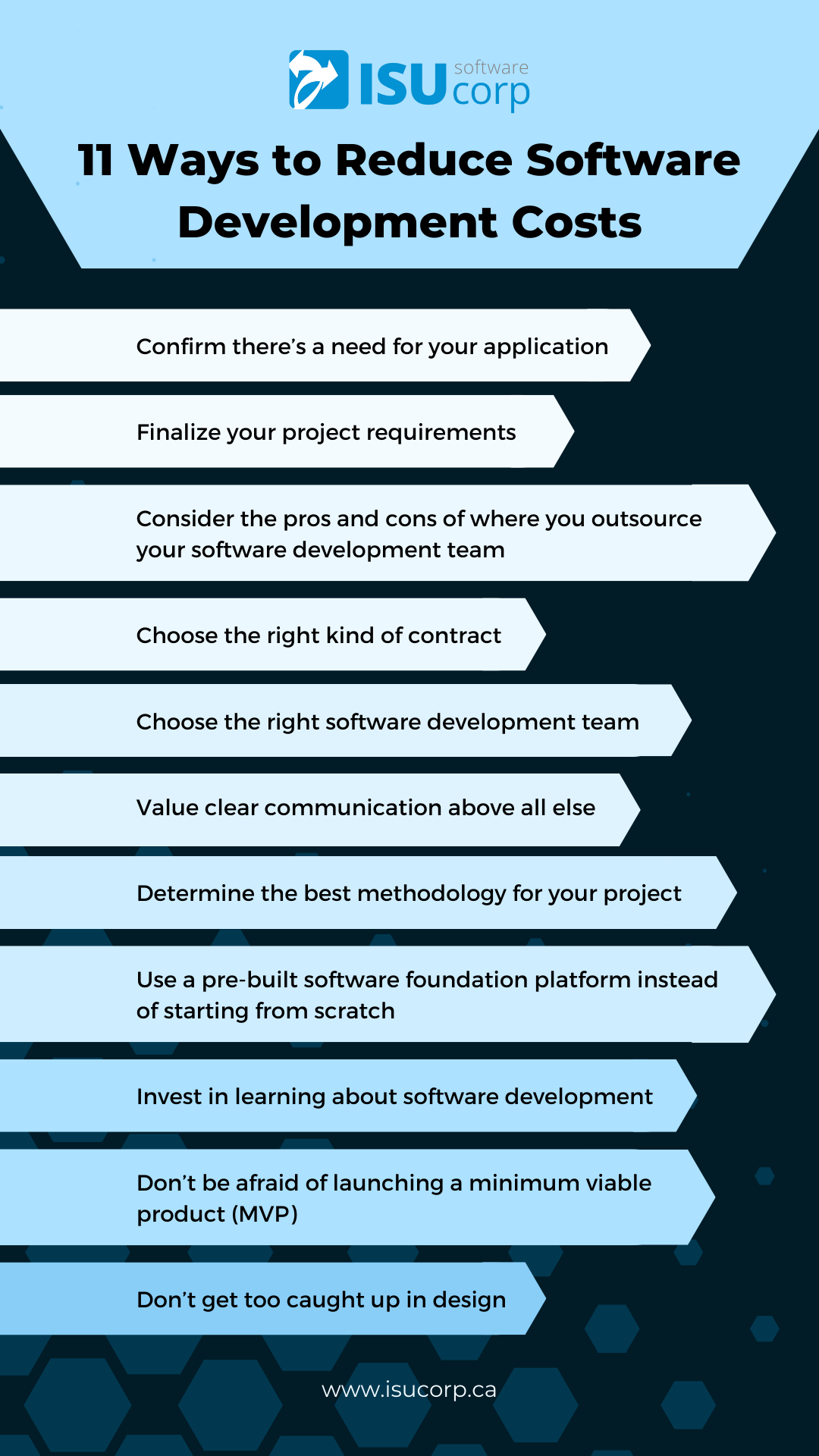Introduction
There is always a pressing question that businesses everywhere may wonder: Should I build my software in-house or recruit an external development partner?
This can be a challenging question to navigate since your project is not just about lines of code. When deciding between in-house and external software developing partners you should consider factors such as your business needs, available resources, and timeframe for development.
This comprehensive guide will serve as your compass, navigating the twists and turns when choosing between in-house and external software development.
Pros of In-House Software Development
Communication
A benefit to building your in-house team is the flow of communication. Oftentimes your team is in close range, or even in the same room. This makes communication flow easily and can ensure everyone on your team is always up to date with your business goals.
Expertise
Taking on a project such as software development can be a learning experience for all those involved. If you are interested in building your team's overall knowledge or increasing the size of your company, in-house development can ensure the overall growth of your team as well as their knowledge and expertise on your business software.
Cost
Cost is a factor that is at the top of most business owners' minds. When looking at cost alone in-house development may be an attractive option. If you already have a dedicated IT team, and you are already paying for their salaries. Having an in-house team can be less expensive than hiring an external partner for your project.
Cons of In-House Software Development
Longer Development Time
Now that we’ve discussed the benefits of using an in-house team it is important to consider some of the downfalls when choosing this option.
An in-house team may have other daily tasks or responsibilities that may take priority over your software development project. Sometimes these responsibilities may push back your timelines resulting in a longer completion time.
Skills Shortage
Another potential downfall to consider is the possible gaps in knowledge that your team may have. Although an in-house team may have a deeper understanding of your business wants, needs, and goals, it does not mean they have the expertise to build the software your project may require. This may result in the need for an external software development partner who has the skills and expertise required to build your project.
Cost Overruns
Cost overruns should always be a concern when launching a new project. It is widely known that most projects never go according to plan. New problems can arise from seemingly nowhere and without the proper expertise to solve these issues your project may experience stunts in development and massive leaps in your budget.
Pros of External Software Development
Focus on Business Needs
Hiring an external software development partner can be beneficial to any IT project. Partnering with experts in software development can give your IT team the space to focus on the everyday needs of your business while your external team is focused on developing your software.
Recruiting an external team ensures that you are not stretching your current IT team thin and provides the space for your team to focus on daily business operations that help your business run smoothly.
Fresh Eyes and Expertise
With an external team, you are working with seasoned professionals who have completed many other projects and have a proven track record of successful deployments. With an external team, you are paying for knowledge and clarity in moments of uncertainty. In addition, an external team provides a fresh set of eyes when planning the next steps for your business.
Whether you need specialized processes such as automating your business or different approaches to building a software project that works for your business, outsourcing an external team can offer a variety of skills to meet your specific business needs.
Quicker Timelines
It could be argued that the most appealing factor when working with an external partner is the ability to scale your team up or down based on the needs of your business. This allows you to stay ahead of your timelines and complete your project quickly and effectively.
Having a team of experts who know how to turn your project ideas into reality is no doubt a huge benefit to any software project.
Cons of External Software Development
Communication Barriers
Like almost all things, with pros, there must also be cons. A downfall of using external partners lies in the communication barriers. Unlike with an in-house team, external teams can be all over the globe. This can result in both cultural and time zone differences making it more difficult to communicate your business wants, needs, and goals. You can minimize this risk by going with a company that has team members in North American times zones only.
Lack of Control
Another potential downfall to using an external developing partner is the lack of control. Hiring an external team means you must be able to work with a new group of skilled professionals and allow these experts to take hold of some important responsibilities. This means business owners must be open to letting go of some control to ensure the overall success of their project.
Security Risks
Security concerns are always worrisome when working with software especially if you are considering developing a project fit for your business needs.
When dealing with any external partner safeguarding your data should be the first question any business owner discusses. It is important to check out potential partnering companies' security measures and processes for protecting your data. In addition, always be sure to take all necessary legal precautions before sharing your internal data.
6 Step Guide to Choosing In-house vs External Software Development Partners
1. How complicated is your project?
When deciding between in-house software development and external software development, an important consideration is how complex is your project.
If your project has specific requirements that can be challenging to navigate, quick scalability, or extensive resources, an external software development partner may be more beneficial in the long run.
on the other hand, if your project's goals align with the strengths of an in-house team and maintaining control over the entire development process is a non-negotiable, an internal approach might be a better fit for you.
When deciding between internal and external approaches it is important to carefully evaluate your project's complexity, this will guide the decision-making process and will guarantee your primary business goals are at the forefront of your project.
2. Who's on Your Team?
When making the crucial decision between in-house and external software development, it's important to take notice of who's on your team.
Consider who is on your internal team, do you have the resources and the knowledge you need to build your dream software project?
If you are fortunate enough to have a large IT team, with experts in multiple areas of software development you can dedicate certain people to specific projects.
Although this is the dream, most companies cannot afford such a team as this would be very costly. Most teams are made up of skilled workers who perform multiple different tasks and influence the way you choose to structure your team or build your software project.
3. What Is Your Budget?
Cost is a factor that is always important to consider when delving into any new projects. This can be overwhelming to any business owner as cost is not always black and white. Many factors can impact your overall budget other than just the cost of your team.
when opting for an external partner, you will have access to many different experts, this means you will not have to invest in other tools that you may need to complete your project. This can include testing and designing expertise.
If you have the overhead to develop your own in-house team of experts your business will surely benefit. However, for a more budget-friendly option for software development that produces quality projects consider finding an external software development partner that matches your company's goals and values.
4. What Is Your Timeline?
When deciding between in-house development and external software development partners, a crucial factor to consider is your time-to-market timeline.
You must be sure to measure the urgency of getting your product or solution to market and the time needed for development. If convenience is at the forefront and a quick launch is critical, an external software development partner with a proven track record of quick and accurate delivery may be the best choice for you.
on the other hand, if you have the luxury of a more flexible timeline and would like to maintain a higher degree of control over the development process, building an in-house team might be a strategic decision.
Internal teams often allow for more smoother and accurate communication, which can be beneficial for specialized projects that need close teamwork.
Overall, when choosing between in-house or external development partners make sure to be highly considerate of your business's time-to-market goals.
5. Communication Barriers
When developing your software project, communication plays a critical role, and understanding how your team communicates can make or break the success of your project.
As discussed above, an in-house team benefits from the closeness and a shared physical workspace that provides quick and direct communication. Team members can quickly address unexpected issues and share insights with your whole team regarding your project. In addition, an in-house approach allows your team to problem-solve while pushing a real-time and collaborative work environment.
On the flip side, external software development partners may present potential communication barriers. This can include time zones, language, and cultural differences.
It is important to consider that managing projects remotely demands a specific approach to communicating. This can be done by using different tools, and protocols to establish clear channels of communication. To ensure these barriers have a minimal impact on your project be sure to discuss these protocols with potential external partners.
Finding the right balance between the ease of communication you get with an in-house team and the strategic coordination used by a successful external team is key to navigating the challenges you may face when developing your software project.
6. Long-Term Strategy and Control
When considering long-term strategy and control for your software development project, the choice between in-house and external development partners is crucial.
Opting for an in-house team allows for a higher degree of control over the entire development process and can be beneficial when immediate adjustments are needed.
In addition, in-house development provides the space to change direction strategically and seamlessly to align with everyday business goals and needs. This encourages the alignment of company culture with long-term objectives and creates an environment of in-house expertise.
However, this approach may require a costly upfront investment for recruiting workers for your skilled team. In addition, large investments may also be needed for infrastructure.
On the other hand, when recruiting an external software development partner, you can benefit from the cost reductions in talent recruitment. Moreover, external partners promote quick scalability for your software project while also giving you access to the skilled workers that will lead your project to success.
Finding the right balance for your project requires a careful assessment of your strategic priorities, the specialized skills needed for your project, and your organization's overall goal for growth and innovation.
Other Considerations
Security considerations should always be a primary concern when deciding between in-house or external software development partners.
In-house development gives business owners a higher level of control over how and what security measures are used to keep their data safe. In-house development provides organizations with the power to use personalized protocols and the ability to closely monitor access. In-house development also gives you the ability to conduct regular security audits and quickly address any vulnerabilities that may impact the security of your project.
On the other hand, hiring an external software development partner presents an additional layer of challenges. While reputable external partners usually stick to rigorous security standards, trusting an external team with your sensitive data and intellectual property can be scary and overwhelming. It is crucial that you properly vet your potential partners and make sure that your ideas surroundings security protocols and safeguarding of your data are in alignment.
Furthermore, it is important to make sure that contractual agreements are made and are in line with industry standards and regulations. Additionally, enforcing transparent communication with external partners on security protocols will ensure minimal risk potential.
Conclusion
Now equipped with this comprehensive guide, your software journey will not just be a success, but also a thrilling adventure! Make informed decisions, navigate the challenges, and watch your digital dreams unfold with confidence.
The world of software development is big and dynamic, and with the right knowledge in hand, your project will be nothing short of a success, allowing you to scale your business!
What are your thoughts? Which option would you choose? Let us know in the comments.
If you need any help or guidance with choosing in-house or outsourcing software development, feel free to contact us. We are a team of experts who can help you design and implement the best custom software solutions for your business.
Written by Natalia Duran
—
ISU Corp is an award-winning software development company, with over 17 years of experience in multiple industries, providing cost-effective custom software development, technology management, and IT outsourcing.
Our unique owners’ mindset reduces development costs and fast-tracks timelines. We help craft the specifications of your project based on your company's needs, to produce the best ROI. Find out why startups, all the way to Fortune 500 companies like General Electric, Heinz, and many others have trusted us with their projects. Contact us here.























